Exploring the 10 Point Diamond: Size and Value Insights
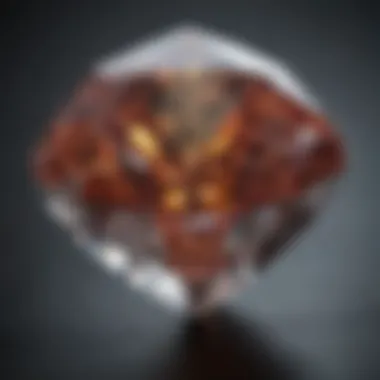
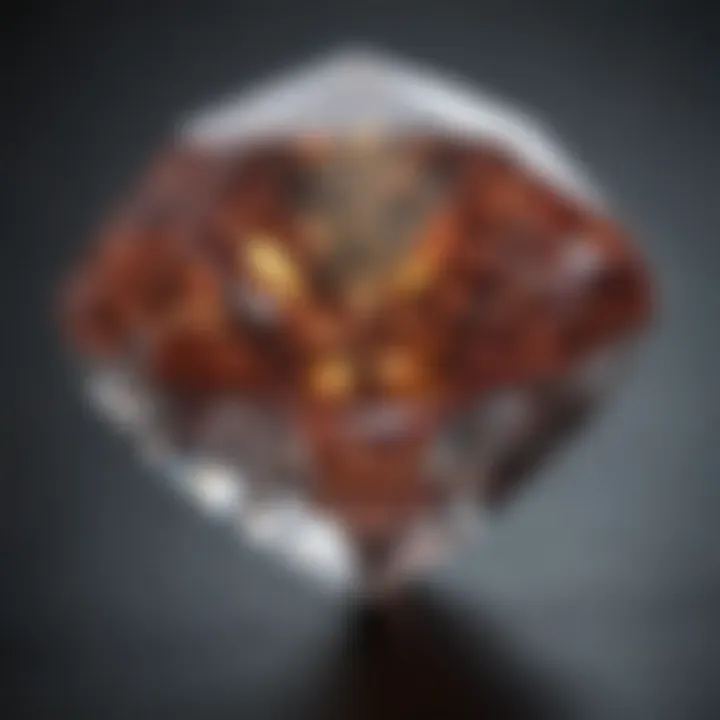
Gemstone Overview
When it comes to the world of gemstones, understanding what you're dealing with is crucial. A 10 point diamond, which weighs just 0.1 carats, might not be the largest stone in the box, but it can pack a punch in terms of value and beauty. A typical characteristic of diamonds is their ability to reflect and refract light, giving them a sparkly appeal that catches the eye. The dimensions and proportions of a diamond greatly influence its visual impact. Within this section, we will explore how a 10 point diamond sits within the broader context of gemstones.
Definition and Characteristics
Diamonds are formed deep within the Earth under extreme pressure and heat. Their unique crystalline structure is what gives them exceptional hardness and brilliance. A 10 point diamond may be small, but it is still formed from the same mineral—carbon—like its larger counterparts. Its dimensions typically measure somewhere around 2.4mm for a round cut, illustrating that size isn't everything in the gemstone universe.
Key characteristics include:
- Cut: This affects how light interacts with the stone, impacting its sparkle.
- Color: Ranges from colorless to light yellow or brown, with fewer hues often valued more highly.
- Clarity: Refers to the internal flaws or inclusions that might affect brilliance.
In essence, understanding these attributes aids in distinguishing among diamonds of various sizes, including our focus: the 10 point diamond.
Classification of Gemstones
Gemstones can be broadly classified into precious and semi-precious categories. Diamonds belong to the precious category, alongside rubies, sapphires, and emeralds. While this classification has historical roots, the distinction often comes down to commercial value and desirability.
Focusing not just on diamonds but the wider category of gemstones, one might find it interesting to categorize them in several ways:
- According to their chemical composition (e.g., oxides, silicates).
- Based on their crystalline structure, which includes monoclinic or cubic forms.
- In terms of their historical significance and lore. All of this provides deeper insight into how people perceive and value different stones.
Historical Significance
The allure of diamonds extends beyond their physical attributes; they have been a part of human history since ancient times. Through wars, trade routes, and economies, gemstones like the 10 point diamond have left an indelible mark.
Ancient Uses and Cultural Importance
Historically, diamonds were thought to have powers of protection and invincibility. Kings and rulers wore them not just for beauty, but to symbolize their power. Various cultures have linked gemstones to astrology, with many believing that specific stones would bring good fortune or health.
In ancient India, diamonds were believed to hold healing properties and were used in treaties to signify loyalty and friendship. This significance has transcended time, as today’s buyers often carry similar beliefs regarding the emotional weight of their diamond purchases.
Myths and Legends Surrounding Gemstones
Diamonds have also spawned countless myths. For instance, it is said that a diamond's brilliance is enhanced during a full moon, making it a preferred choice for rituals and celebrations. Moreover, the adage "diamond is a girl’s best friend" serves as a reminder of how deeply woven into society these stones have become.
"A diamond is forever." This catchphrase has solidified diamonds not only as tokens of love but also as enduring investments.
By diving into the characteristics, history, and significance of diamonds, especially the modest 10 point variety, we can appreciate the broader implications of gemstones in our culture.
This understanding lays the groundwork for how size correlates with value in the world of diamond appraisal, leading us to further assess how a 10 point diamond might fit into your gemstone or jewelry collection.
Prelims to Diamond Measurement
Understanding how diamonds are measured is fundamental for anyone interested in purchasing or collecting them. It helps to grasp not just the numerical values associated with carat weight but also the relationship between size, appearance, and overall value. This aspect of gemology lays the groundwork for discerning buyers and enthusiasts alike to make educated choices in what is often a significant financial investment.
When diving into the topic of diamond measurement, one quickly encounters the concept of "carats" which, despite being a commonly used term, often leads to misconceptions. A clear understanding of carat weight, along with other dimensions like cut, clarity, and color, plays a crucial role in appreciating a diamond's true worth. The nuances of size measurements can also shift depending on various factors, making mastery of this subject incredibly beneficial.
Moreover, shaping one’s knowledge around diamond measurements enhances the overall experience of engagement with these beautiful gems. Whether one is purchasing an engagement ring or simply seeking to learn more about gemstones, being well-versed in sizing can empower an informed discussion with jewelers and fellow enthusiasts. That’s what this section aims to achieve—an insightful introduction that sets the stage for deeper exploration of specific measurement facets that will follow.
Understanding Carat Weight
Carat weight is generally the first parameter that comes to mind when considering a diamond's size. One carat is equivalent to 0.2 grams, but weight alone can be misleading without considering the diamond's cut and dimensions. A diamond with ideal proportions may appear larger than a heavier stone poorly cut. This phenomenon often causes buyers to fixate solely on the carat number without considering how the overall craftsmanship can significantly influence visual impact.
The often-overlooked yet tangible aspect of carat weight is how it can appear visually different depending on the shape of the diamond. For example, a round-brilliant cut diamond and a pear-shaped diamond weighing the same may not look equally substantial. This leads to confusion, especially among those who may be relatively new to navigating the complex world of gemstones.
Importance of Size in Jewelry
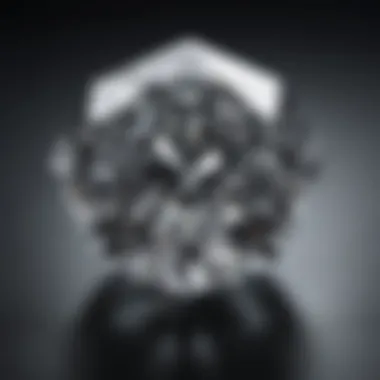
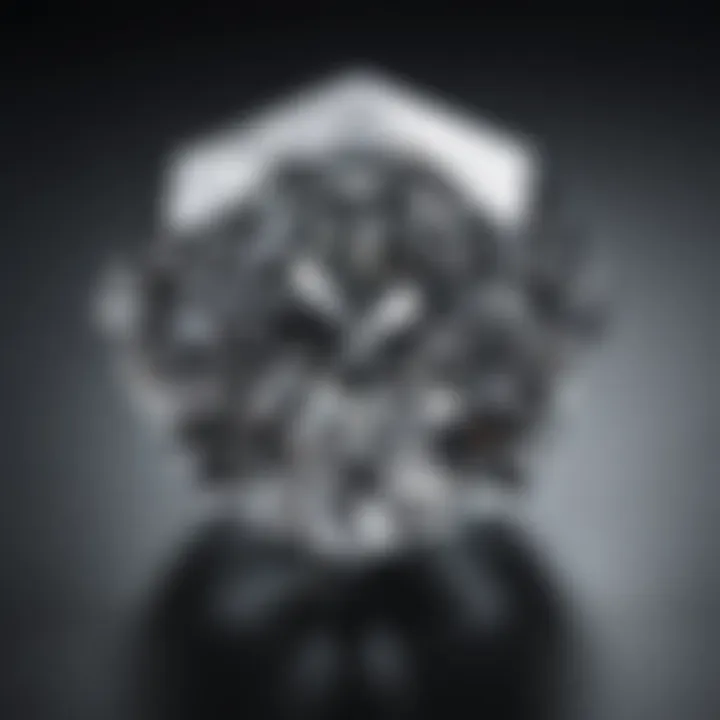
The size of a diamond frequently takes center stage in jewelry design. An eye-catching size not only enhances visual appeal but also conveys status and opulence. The significance bestowed upon larger stones is deeply ingrained in societal perceptions. Many buyers associate size with quality, often overlooking finer details such as cut and clarity that significantly affect a diamond's brilliance.
In jewelry design, size matters as it factors into how the piece is visually balanced. A statement piece could be more suitable for a larger diamond, while a delicate setting might be better suited for smaller stones. To that end, understanding the importance of size can be particularly beneficial for jewelry designers, as they can make informed decisions that enhance their crafts.
"A diamond's significance often isn’t measured just by its carat weight but how it looks within the context of the design."
Having a solid footing in the knowledge of diamond dimensions brings clarity not just to buyers and collectors, but also to those who design jewelry or simply appreciate gemstones. The pursuit of beauty combined with a well-rounded understanding of size and its implications adds depth to the overall gemstone experience.
What is a Point Diamond?
When we talk about diamonds, especially in the realm of jewelry, understanding the specifics of a 10 point diamond is crucial. This small but significant measurement plays a role far beyond its mere size. For gem enthusiasts and collectors alike, the 10 point designation, equating to 0.10 carats, means more than just weight; it resonates with characteristics like value, cut, and even emotional resonance. Knowing these details can help in making informed purchases or appraisals.
Defining Points in Diamond Sizing
A point is a fundamental unit in the gemstone world, quantifying weight in a precision-focused manner. One point equals one-hundredth of a carat. To put this into perspective, a 10 point diamond being equal to 0.10 carats can easily become a standout in a collection without overwhelming the senses.
Consider the measurements:
- Visual Appeal: At this weight, diamonds are often small enough to be set in delicate jewelry designs, making them perfect for elegant rings, earrings, or pendants.
- Affordability: 10 point diamonds are relatively more affordable compared to larger stones. This opens up avenues for buyers who want quality without breaking the bank.
- Market Demand: Despite their size, these diamonds cater to a niche market where collectors value them for their quality rather than mere size.
It's also critical to understand that while carat weight measures size, it does not necessarily dictate how the diamond will look. The way a diamond is cut can dramatically affect its appearance, often making a well-cut 10 point diamond appear larger than its weight suggests.
Common Misconceptions
With any specific measurement like the 10 point diamond, misconceptions can lead potential buyers to misunderstand its value and potential.
- Size Over Quality: A common fallacy is that larger diamonds are inherently better. A 10 point diamond could potentially have superior clarity, color, and cut compared to larger stones that suffer from flaws.
- Rarity: Some believe that smaller diamonds are common and therefore lack uniqueness. In reality, properly sourced diamonds, irrespective of size, are becoming harder to find.
- Market Value: Many might think that a lower carat weight translates to less investment value, but that isn’t always true. Collectors and investors increasingly recognize that a high-quality 10 point diamond can be a smart investment, particularly as trends in the market evolve.
The 10 point diamond, when understood in the right light, offers a fascinating blend of accessibility and elegance, making it a worthy addition to any jewelry box.
In essence, the journey into understanding what constitutes a 10 point diamond opens a treasure chest of insights. By grasping the significance of point measurements, as well as dispelling some prevalent misconceptions, one can appreciate the depth at which these small diamonds exist in the larger landscape of the gem world.
Size Comparison of Diamonds
When it comes to diamonds, size often takes center stage in the minds of both buyers and enthusiasts. That's why understanding diamond size comparison is critical. It’s not just about how many carats a diamond weighs; the perception of size is influenced by various factors, which can significantly alter how a diamond is viewed in relation to its worth and visual appeal. Comparing sizes can assist you in grasping the intricacies of choosing the right diamond for any occasion.
Comparing Carat Weights
Carat weight is the most straightforward measure of a diamond's size. One carat is equivalent to 200 milligrams. A 10 point diamond weighs 0.10 carats, which is considered small in the grand scheme of things. However, this doesn’t mean it lacks beauty or practicality. When comparing carat weights, it’s crucial to recognize that two diamonds of similar carat weights can look quite different according to their cut, clarity, and other factors. For instance:
- A well-cut diamond tends to appear larger than one that is cut poorly, even if they share the same carat weight.
- The shape can also play a role; a round diamond, for example, may appear larger than a princess cut diamond of the same weight due to its geometric properties.
A focus on carat weight allows buyers to make informed decisions that reflect not just emotional desires but also the practicality of jewelry purchases. Knowing the carat weight diminishes common misconceptions, aiding buyers in understanding value versus size.
Visual Size Differences
While carat weight gives you a numerical way to gauge size, visual size differences often tell a more compelling story. When you look at a 10 point diamond next to a 20 point diamond, it might seem small, but that small size can shine in settings that draw attention to its sparkle rather than just its heft.
To fully appreciate the visual size differences:
- Setting Style: How a diamond is set in a piece of jewelry can heavily influence how large it appears. For instance, a diamond halo setting can enhance the appearance of even a small stone, making it look more significant than its actual weight.
- Lighting Conditions: The brilliance and sparkle of a diamond can change drastically based on lighting. Under bright lights, even a 10 point diamond can seem large due to the reflections and scintillation.
"Often, the true allure of a diamond lies not in its size but in its ability to catch the light and dazzle the viewer."
When considering visual size differences, it’s beneficial to compare multiple diamonds. Ask to see diamonds of different weights under the same lighting and settings. This practical approach will sharpen your understanding of how size perception can be tricked by various elements.
By digging into carat weights and visual size differences, you obtain a layered view of what it means to choose a diamond. A 10 point diamond may seem minuscule at face value, but understanding these comparisons can shift your perspective dramatically.
Factors Affecting Diamond Size Perception
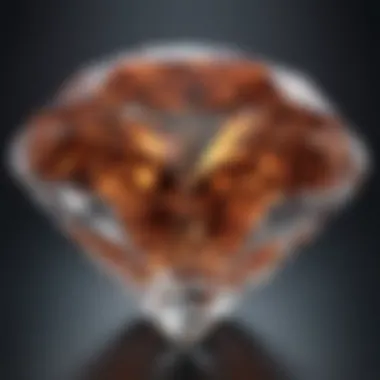
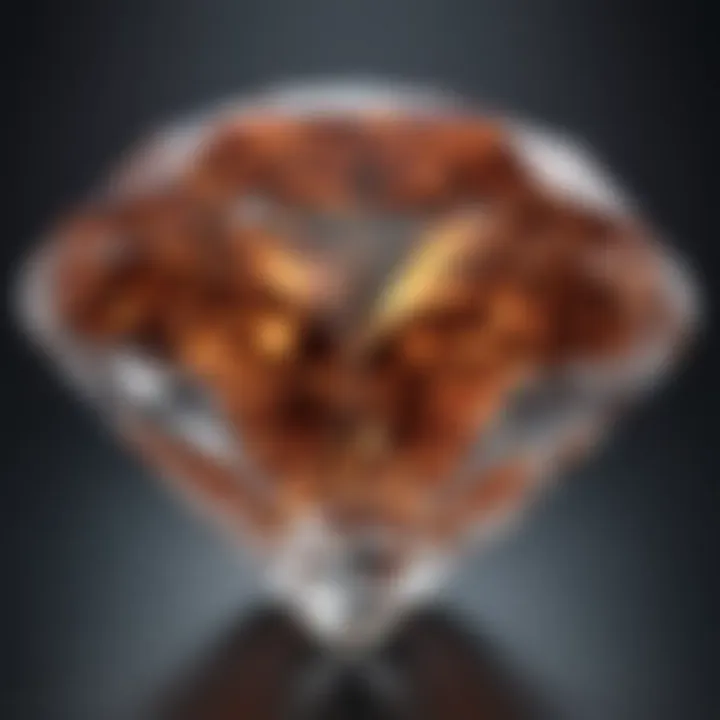
When exploring the world of diamonds, especially a 10 point diamond, understanding the factors that affect size perception becomes vital. Size isn’t just about carat weight; the true appearance can change dramatically based on several elements surrounding the diamond itself. This awareness helps buyers make more informed decisions and elevates their appreciation for the gem's craftsmanship.
Cut and Its Influence on Appearance
The cut of a diamond doesn’t just refer to its shape. It encompasses its proportions, symmetry, and polish, vastly influencing how light interacts with the stone. A well-cut diamond, even at a lower carat weight, can appear larger than its heavier counterpart. This phenomenon often perplexes many buyers, leading to the common saying that a diamond's brilliance can sometimes overshadow its actual weight.
For example, a round brilliant cut often yields more sparkle and fire due to its facets' angles than, say, a cushion cut of the same carat weight. Investing in a higher quality cut, therefore, is often seen as a smarter choice, as it can maximize the visual impact without needing to upsize in carat.
Takeaway: Never underestimate how a diamond's cut can enhance perceived size. A well-cut stone of points may dazzle more than a poorly cut stone twice its weight.
Shape Variations and Their Impact
The shape of a diamond also plays a significant role in how its size is perceived. Different shapes can create illusions of greater size or evoke a sense of elegance. For instance, an elongated shape like an oval often appears larger than a round diamond of equal carat weight. This elongation provides a different visual experience, which might appeal to certain aesthetic preferences.
Another interesting example includes the marquise cut which, due to its pointed ends, can create an impression of length, giving it an air of grandeur.
Moreover, the setting style can complement these shapes. A thin band can accentuate the diamond's size, whereas a thick band may detract from its perceived size.
Consider this: the diamond’s shape can dramatically influence its appearance, and understanding these nuances can make a significant difference in your choice.
Clarity and Color Considerations
Clarity and color are often discussed in terms of quality, but they matter greatly when considering perceived size as well. A diamond with high clarity typically refracts light better, making it sparkle brightly and appear bigger. On the other hand, an included diamond may look smaller due to rough patches and lackluster sparkles.
Color can also have an effect, especially in smaller stones. Diamonds that are slightly yellow may appear smaller compared to their white counterpoints because the color can obscure brilliance and fire, which often magnifies size perception.
In essence, the presence of visible inclusions or a not-so-ideal color grade can make a 10 point diamond look much less enticing than a similar one in terms of transparency and hue.
Important: Always consider clarity and color as critical factors when assessing size perception. A clear, colorless diamond sparkles and visually enlarges more effectively than one that appears murky or tinted.
In summary, understanding these nuances regarding cut, shape, clarity, and color can profoundly influence your choice and appreciation of a 10 point diamond, guiding you toward a wiser decision while navigating the intricate gemstone market.
Market Value of Point Diamonds
The market value of a 10 point diamond is an essential topic for anyone involved in the jewelry industry, from buyers and sellers to collectors. Understanding this market value helps one navigate the unpredictable waters of gemstone pricing. Unlike larger diamonds, which have more established pricing structures, a 10 point diamond can vary significantly based on various factors. Recognizing these influences is crucial for making informed purchasing decisions.
Pricing Trends in the Gemstone Market
In recent years, the pricing trends in the gemstone market have shown interesting patterns, particularly for smaller diamonds like the 10 point variety. These diamonds often appeal to budget-conscious buyers looking for quality within a specific price range. Factors influencing pricing include:
- Market Demand: When economic conditions are favorable, the demand for all diamond sizes generally rises. Buyers seeking gifts or personal treats may flock to 10 point diamonds as a more affordable option.
- Rarity: Though 10 point diamonds are not rare in terms of availability, unique color or clarity characteristics can make specific stones more desirable.
- Cultural Preferences: Trends in regions can vary. For example, certain cultures may prefer smaller stones due to minimalist trends in jewelry design, impacting the overall market value.
- Seasonal Sales: Prices might dip during off-peak seasons, making it an excellent time for buyers. By staying attuned to these fluctuations, enthusiasts can find better deals.
"Pricing trends reflect not just the physical attributes of diamonds but also the emotional connections buyers forge with them."
Investment Potential
The investment potential of 10 point diamonds can be somewhat nuanced. Unlike larger diamonds, whose value might be more easily calculable, smaller stones offer unique attributes that can influence their investment appeal. Here are some considerations:
- Affordability: For new investors, entering the diamond market with smaller stones can be less intimidating. A 10 point diamond offers a way to dip one’s toes in without breaking the bank.
- Portability: Smaller diamonds are easier to store and transport, making them practical for collectors aiming to diversify their investment portfolios without heavy physical assets to manage.
- Niche Markets: Investors might find significant potential in niche markets for colored or uniquely cut 10 point diamonds. Often, these stones can appreciate in value more rapidly compared to their more common counterparts.
- Market Education: Those interested in investing in diamonds should educate themselves on how the value of smaller stones fluctuates. It’s important to regularly review and adapt one’s investment strategy based on the market dynamics at play.
Overall, understanding the market value of a 10 point diamond not only assists in making smarter purchases but also opens up new avenues for potential investments. As gem enthusiasts and collectors deepen their knowledge of these stones, they are better equipped to navigate the complexities of the diamond market.
Practical Buying Tips
When it comes to purchasing a 10 point diamond, understanding the intricacies is key. This isn't just about selecting a pretty stone; it involves a careful assessment of quality, value, and what aligns with your personal tastes or investment goals. Engaging with a knowledgeable jeweler or doing thorough research can save you from costly mistakes that buyers new to the game often encounter.
A well-informed buyer can discern subtle differences in quality and craft that are crucial in this nuanced field. Good advice and diligent evaluations can lead you to a gem that sparkles not just in appearance but also in value over time.
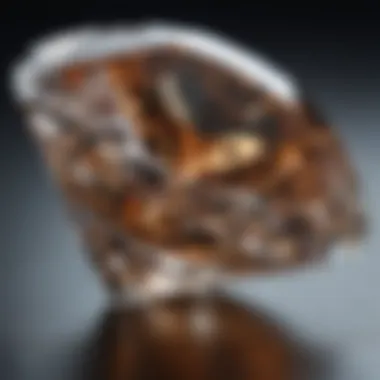
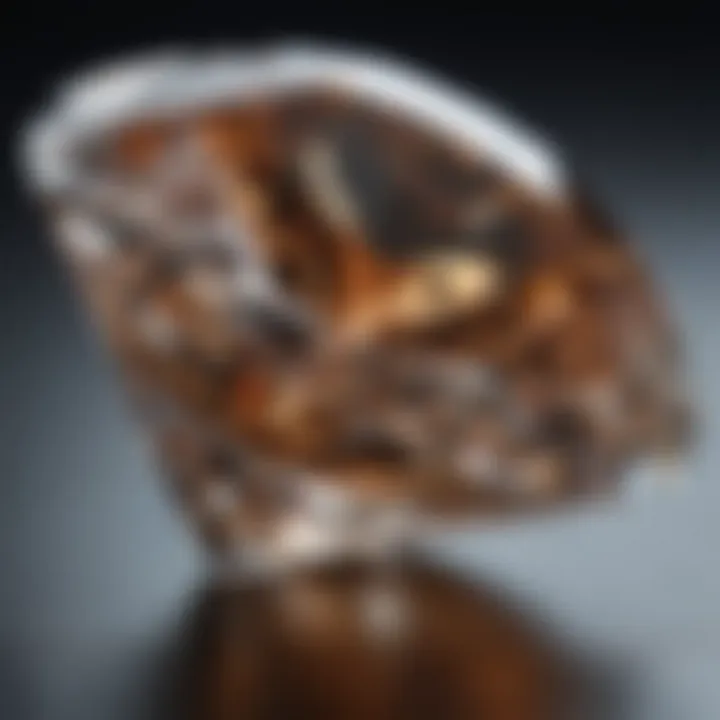
Evaluating Quality Before Purchase
Delving into the quality of a diamond means grasping the four Cs: cut, color, clarity, and carat weight. For a 10 point diamond, each of these attributes plays a pivotal role in its overall presence.
- Cut: This determines how well the diamond reflects light. A poorly cut diamond, even with exceptional clarity, can appear dull.
- Color: Diamonds are graded on a scale from D (colorless) to Z (light yellow). A high-quality diamond in this range can enhance beauty more than a larger, tinted stone.
- Clarity: Refers to the presence of internal or external imperfections. The fewer blemishes or inclusions, the more valuable the diamond tends to be.
- Carat Weight: As you know, this indicates the size of the diamond. In the case of a 10 point diamond, the scale may make it seem relatively tiny, yet don’t let that fool you. Quality diminishes if aspects like cut and clarity aren’t taken into account.
By encapsulating these factors, you create a solid foundation for your diamond buying journey. Never hesitate to ask for the gemologist’s report that provides insight into each of these areas. Furthermore, visually examine the diamond under different lights to appreciate how it truly shines.
Understanding Warranty and Certification
Before sealing the deal, it’s crucial to ensure that your diamond is certified. Reputable gemological laboratories like the Gemological Institute of America (GIA) or the American Gem Society (AGS) provide certificates that authenticate your purchase. These documents confirm the quality attributes of the diamond and can also protect you against fraud.
Equally important is to check the warranty that often comes with diamond purchases. Not only does this give you consolation in case of accidental damage, but it may also cover necessary maintenance checks—like periodic cleaning and inspections.
Consider the following points when navigating warranties and certifications:
- Duration: How long does the warranty last? Does it cover full replacement?
- Conditions: Are there specific conditions or exclusions that you should be aware of?
- Transferability: If you decide to sell your diamond in the future, is the warranty transferable to the new buyer?
Having a thorough understanding of these elements can significantly enrich your purchasing experience, ensuring that you feel confident and secure in your investment.
Caring for Your Point Diamond
Caring for a 10 point diamond is not just about keeping it shiny; it’s about preserving its beauty and value for years to come. Diamonds, despite being the hardest natural material on Earth, still require proper maintenance and protective measures. This section explores the essentials of cleaning and safe storage, ensuring that your gem remains as stunning as the day you acquired it.
Cleaning and Maintenance Practices
To keep your 10 point diamond looking its best, establishing a routine cleaning process is essential. Regular maintenance not only improves the diamond's appearance but also extends its lifespan. Here are some effective cleaning practices:
- Gentle Soap Solutions: Mix mild dish soap with warm water. Soak the diamond in the solution for a few minutes. This helps dissolve any accumulated grime. Use a soft brush, such as a toothbrush, to clean the diamond carefully, focusing on the base where dirt typically collects.
- Avoid Harsh Chemicals: Chemical cleaners or abrasives can scratch the diamond or damage its setting. Stick to gentle, non-toxic cleaners.
- Ultrasonic Cleaners: While these high-frequency cleaning devices are effective for many types of jewelry, use caution. Some diamond settings may not withstand the vibrations that these machines produce. Always check with a professional first.
- Professional Cleaning: For deeper cleans and to check for any potential damage, consider having your diamond evaluated by a jeweler every year. They can also inspect the metal setting for any loose prongs.
“A little effort in care goes a long way. Regular maintenance not only keeps your diamond sparkling but also enhances its value.”
Storing Your Jewelry Safely
How you store your 10 point diamond can make a significant difference in its longevity and overall condition. Proper storage minimizes potential damage from scratches and environmental factors. Here are some guidelines for safe storage:
- Separate Storage: Always store your diamond separately from other jewelry. This can prevent scratching from other gemstones or metal surfaces. Use individual soft pouches or a dedicated jewelry box.
- Avoid Humidity: Moisture can cause tarnishing in metals and cloudiness in diamonds. Store your diamond in a dry area, preferably with silica gel packets to absorb excess moisture.
- Temperature Control: Extreme temperatures can affect the integrity of diamonds and their settings. Aim to store jewelry in an area with consistent, moderate temperatures.
- Security Considerations: If your diamond has significant value, consider secure storage options like a safe or a safety deposit box. This not only protects your investment but also gives you peace of mind.
By following these simple yet effective practices, you can ensure that your 10 point diamond remains a dazzling piece of jewelry for all occasions.
End and Final Insights
Understanding the intricacies of a 10 point diamond goes beyond mere numbers; it entails a depth of knowledge that enhances appreciation for these small yet significant gems. This section wraps up the previous discussions by highlighting essential elements that have been explored throughout the article, ensuring a comprehensive grasp of the topic.
In reviewing key aspects, let's consider size, perceived value, and the factors that inflate or diminish the appeal of a 10 point diamond. Sizes vary with slight increments, each bringing distinct characteristics to the forefront. A diamond that weighs in at just 10 points (or 0.10 carats) can still boast a majestic presence, thanks to outstanding cut quality and clarity. A truly well cut diamond can give the illusion of greater size, thus altering perceptions as it captures and refracts light beautifully.
Furthermore, the discussion on market value intricately ties into this understanding. Consumers and collectors alike must discern how size, shape, and clarity translate into worth. This holistic approach is crucial not just when purchasing but also in appreciating the stone's uniqueness and inherent characteristics. As buyers navigate the market, they're equipped with valuable insights that allow for well-informed decisions.
"Knowledge is not power; it is potential power."
- Dale Carnegie
Collectively, this understanding invites an engaged dialogue about the world of diamonds. Each stone is a captivating story waiting to be uncovered, reinforcing the point that a deeper dive into its dimensions can unveil treasures hidden in plain sight.
Recap of Key Points
To sum up, the journey through the dimensions of a 10 point diamond revealed several pivotal points:
- Carat Weight: A clear grasp of how a diamond’s carat impacts size and value.
- Visual Perception: The interplay of cut quality, shape, and clarity significantly affects how a diamond is perceived.
- Market Dynamics: Understanding pricing trends and what elevates or lowers a diamond’s value in the gem market.
- Practical Buying Tips: Strategies to assess quality, maintenance tips, and the importance of certifications.
- Care and Maintenance: Knowing how to maintain these magical gems to keep their brilliance for years to come.
Encouragement for Informed Decisions
As you step into the world of diamonds, always remember to equip yourself with knowledge. The marketplace is filled with stunning options, but discernment is what will set you apart as a collector or a savvy buyer. Be proactive in seeking information, be it through expert consultations, detailed readings, or community discussions in forums such as reddit.com.
Hence, whether you're considering that perfect 10 point diamond for a gift or as an investment, approaching the process with an informed mindset allows for richer choices and ultimately a greater appreciation for gemology. Armed with insights from this article, you are better positioned to ensure that your selections are not just beautiful but also reflect a sound understanding of the diamond's dimensions.







